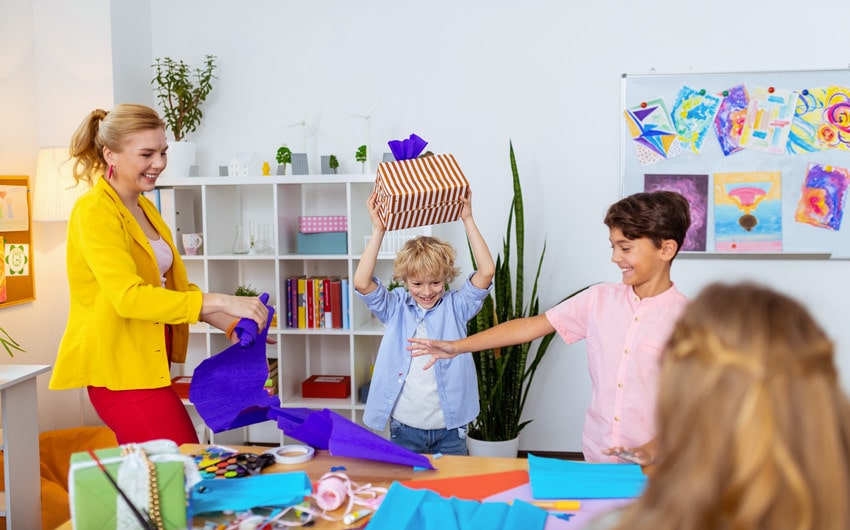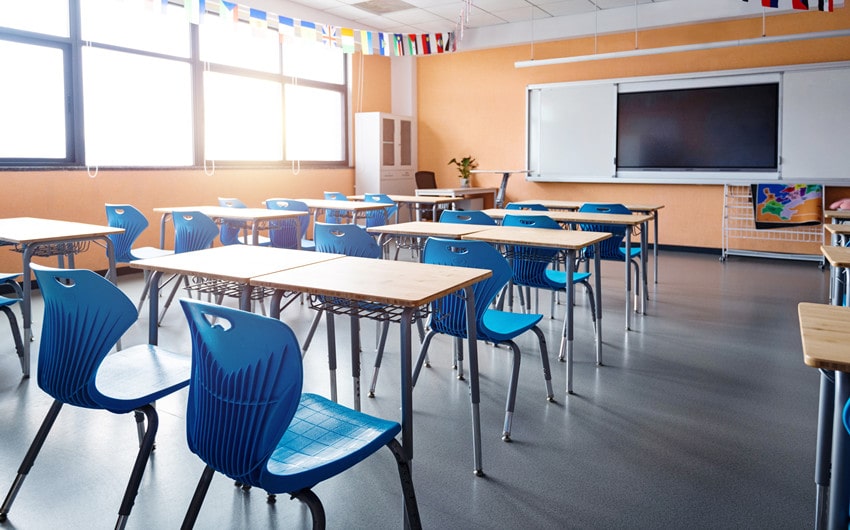40 Classroom Theme Ideas to Transform Your Learning Space
Creating an engaging learning environment can be as simple as choosing the right theme for your classroom. Whether you’re teaching young kids or older students, the right classroom theme ideas can transform your space into a place where creativity and learning thrive.
From nature-inspired setups to literary adventures, finding a theme that resonates with your students makes education more exciting and meaningful. This guide will explore various classroom theme ideas to help you craft a setting that inspires and motivates every day.
Popular Classroom Theme Ideas
A. Nature and Outdoors

Nature and outdoor themes bring the calming and inspiring elements of the natural world into the classroom, encouraging students to connect with and learn about the environment.
1. Forest Adventure
-
- Decor: Use tree cutouts, animal posters, and green, earthy tones to create a woodland atmosphere.
- Classroom Setup: Create a reading nook with bean bags surrounded by faux trees. Hang a canopy of green leaves to simulate the forest canopy.
- Activities: Nature journaling, studying local wildlife, and creating forest ecosystem dioramas.
2. Under the Sea
-
- Decor: Transform the classroom into an underwater world with fish, coral, and sea creatures. Use blue shades, fish nets, and seashells for decor.
- Classroom Setup: Create a “coral reef” reading corner with soft blue rugs and sea-themed cushions. Use hanging fish and jellyfish made from paper lanterns.
- Activities: Learning about marine life, researching ocean conservation, and creating sea creature art projects.
3. Space Exploration
-
- Decor: Turn the classroom into a galaxy with planets, stars, and astronauts. Use dark blue and black with glow-in-the-dark stars and planets.
- Classroom Setup: Create a “Mission Control” area with computers and headsets, and a “space station” reading corner.
- Activities: Building model rockets, studying the solar system, and simulating a space mission.
4. Rainforest Retreat
-
- Decor: Use lush greenery, tropical flowers, and exotic animals. Decorate with hanging vines and large leaves.
- Classroom Setup: Create a “jungle explorer” station with binoculars and maps. Use a large mural of the rainforest as a focal point.
- Activities: Learning about rainforest ecosystems, researching endangered species, and creating rainforest-themed art.
5. Desert Oasis
-
- Decor: Incorporate cacti, sand dunes, and desert animals. Use warm tones like tan, orange, and gold.
- Classroom Setup: Create a “desert explorer” corner with sand-colored rugs and desert animal plush toys.
- Activities: Studying desert climates, learning about plant and animal adaptations, and creating desert landscape models.
B. Travel and Around the World
Travel and cultural themes inspire curiosity about global cultures, fostering an appreciation for diversity and encouraging students to explore the world beyond their own borders.
1. World Cultures
-
- Decor: Use artifacts, traditional clothing, and flags from various countries. Create a “world map wall” where students can mark places they learn about.
- Classroom Setup: Set up “cultural stations” with artifacts, photos, and books from different countries.
- Activities: Cultural presentations, international food tastings, and virtual tours of famous landmarks.
2. Famous Landmarks
-
- Decor: Feature iconic landmarks like the Eiffel Tower, Great Wall of China, and Pyramids of Giza. Use images, models, and posters of these landmarks.
- Classroom Setup: Create a “passport station” where students can collect stamps as they learn about each landmark.
- Activities: Research projects on landmarks, creating landmark models, and presentations on their historical significance.
3. Global Explorers
-
- Decor: Use maps, compasses, and explorer gear. Decorate with globes and travel-themed posters.
- Classroom Setup: Create an “explorer’s corner” with maps, journals, and explorer hats.
- Activities: Geography challenges, virtual field trips, and explorer-themed scavenger hunts.
4. Continental Tour
-
- Decor: Highlight each continent with dedicated areas in the classroom, using symbols and colors representing each region.
- Classroom Setup: Create “continent zones” where students can learn about different cultures, climates, and wildlife.
- Activities: Research projects on continents, continent-themed art projects, and presentations on regional customs.
5. Passport to Learning
-
- Decor: Give each student a “passport” that they can stamp as they “visit” different countries through lessons and activities.
- Classroom Setup: Set up “learning destinations” with cultural artifacts, books, and maps.
- Activities: Virtual tours, learning about customs and traditions, and creating cultural presentations.
C. Superheroes and Positive Character Traits
Superhero themes inspire students to embody positive traits like kindness, responsibility, and perseverance, making learning fun and empowering.
1. Superhero Academy
-
- Decor: Create a superhero training facility with capes, masks, and emblems. Use bold, primary colors like red, blue, and yellow.
- Classroom Setup: Set up “hero stations” where students can create their superhero alter egos and design their own costumes.
- Activities: Creating superhero personas, discussing character traits, and engaging in teamwork challenges.
2. Power of Kindness
-
- Decor: Highlight superheroes known for acts of kindness. Create a “kindness wall” where students can post good deeds.
- Classroom Setup: Set up a “kindness corner” with books and activities focused on empathy and compassion.
- Activities: Random acts of kindness, creating “kindness capes,” and holding a “kindness challenge” week.
3. Respect and Responsibility
-
- Decor: Focus on superheroes who demonstrate respect and responsibility. Display classroom rules aligned with these values.
- Classroom Setup: Create a “responsibility chart” where students can track their positive behaviors.
- Activities: Role-playing scenarios that require responsible decision-making and creating personal responsibility pledges.
4. Courageous Leaders
-
- Decor: Highlight superheroes who show bravery and leadership. Use strong, empowering colors like gold and black.
- Classroom Setup: Create a “leadership corner” with biographies of famous leaders and role-play scenarios.
- Activities: Leadership challenges, discussions about historical figures, and creating “leader profiles.”
5. Everyday Heroes
-
- Decor: Emphasize that everyone can be a hero. Use images of real-life heroes like firefighters, doctors, and teachers.
- Classroom Setup: Create a “hero hall of fame” where students can learn about and celebrate everyday heroes.
- Activities: Storytelling about personal heroes, community service projects, and creating “hero awards” for classmates.
D. Literary and Book-Themed Classrooms
Literary themes immerse students in the world of books, encouraging a love for reading and creative thinking.
1. Harry Potter
-
- Decor: Transform the classroom into Hogwarts with house banners, spellbooks, and magical creatures. Use rich, deep colors like burgundy, gold, and emerald.
- Classroom Setup: Create “house tables” for group work, with students sorted into Hogwarts houses.
- Activities: Sorting ceremony, themed reading challenges, and “magical” science experiments.
2. Dr. Seuss
-
- Decor: Create a whimsical world with bright, primary colors and illustrations from Dr. Seuss books. Use famous quotes and characters like the Cat in the Hat and the Lorax.
- Classroom Setup: Set up “Seussical stations” with different activities inspired by his books.
- Activities: Rhyming games, Seuss-inspired art projects, and reading Dr. Seuss books aloud.
3. Storybook Forest
-
- Decor: Turn the classroom into an enchanted forest with fairy tale characters, trees, and magical creatures. Use soft, natural colors and twinkling lights.
- Classroom Setup: Create a “storybook corner” with fairy tale books and a cozy reading area.
- Activities: Writing their own fairy tales, creating storybook dioramas, and fairy tale reenactments.
4. Mystery Detectives
-
- Decor: Build a theme around classic detective stories, with magnifying glasses, footprints, and secret codes. Use dark, mysterious colors like black, purple, and green.
- Classroom Setup: Create a “detective’s desk” where students can solve mysteries and puzzles.
- Activities: Solving classroom mysteries, reading mystery novels, and creating secret codes.
5. Classic Literature
-
- Decor: Focus on classic novels and their settings, like “Pride and Prejudice” or “Moby Dick.” Use period-appropriate items and scenes from the books.
- Classroom Setup: Create “literary corners” dedicated to different classic books, with relevant props and decor.
- Activities: Book discussions, character analysis, and reenacting scenes from classic literature.
E. STEM and Technology

STEM themes foster a love for science, technology, engineering, and math, encouraging critical thinking and innovation.
1. Robotics Lab
-
- Decor: Create a high-tech classroom with robots, gears, and circuit boards. Use metallic colors like silver, blue, and black.
- Classroom Setup: Set up a “robotics station” with materials for building and programming robots.
- Activities: Building simple robots, coding challenges, and learning about automation.
2. Future Innovators
-
- Decor: Decorate with futuristic imagery, holograms, and cutting-edge tech. Use sleek, modern colors like white, blue, and neon accents.
- Classroom Setup: Create an “innovation hub” where students can brainstorm and prototype their ideas.
- Activities: Inventing new gadgets, coding projects, and future-focused research assignments.
3. Science Wizards
-
- Decor: Combine science and magic by turning the classroom into a lab where “magic” happens through science experiments. Use bright, vibrant colors and “potions” in beakers.
- Classroom Setup: Set up a “wizard’s lab” with science tools and magical decor.
- Activities: Hands-on experiments, exploring the science behind magic tricks, and creating “magic potions.”
4. Space Mission Control
-
- Decor: Design the classroom like a space station with control panels, rockets, and astronauts. Use dark blues, blacks, and metallics.
- Classroom Setup: Create a “mission control” area where students can simulate space missions and track their progress.
- Activities: Space-themed simulations, learning about astronomy, and building model rockets.
5. Math Marvels
-
- Decor: Create a math-centric classroom with numbers, equations, and geometric shapes. Use bold, contrasting colors to highlight mathematical concepts.
- Classroom Setup: Set up “math stations” with puzzles, games, and challenges that engage students in problem-solving.
- Activities: Math challenges, geometry art projects, and interactive problem-solving stations.
F. Historical Time Periods
Historical themes take students on a journey through time, bringing history lessons to life and making learning engaging and interactive.
1. Ancient Egypt
-
- Decor: Use pyramids, hieroglyphics, and pharaohs. Use sand-colored tones and gold accents to create an ancient atmosphere.
- Classroom Setup: Create a “pharaoh’s palace” area with artifacts and Egyptian-themed decor.
- Activities: Mummification simulations, creating papyrus art, and studying Egyptian gods.
2. Medieval Times
-
- Decor: Turn the classroom into a medieval castle with knights, dragons, and banners. Use rich colors like red, blue, and gold.
- Classroom Setup: Create a “castle corner” with costumes, shields, and swords for role-playing.
- Activities: Studying feudalism, creating coat-of-arms, and reenacting medieval life.
3. American Revolution
-
- Decor: Focus on the colonial period with images of founding fathers, the Declaration of Independence, and American flags. Use red, white, and blue colors.
- Classroom Setup: Set up a “colonial village” area with period-appropriate props and decor.
- Activities: Reenactments, creating colonial crafts, and discussing the causes of the Revolution.
4. Renaissance Era
-
- Decor: Celebrate the rebirth of art, culture, and science with themes from the Renaissance. Use deep, rich colors like burgundy and gold.
- Classroom Setup: Create a “Renaissance studio” with art supplies and replicas of famous works.
- Activities: Studying Renaissance artists and inventors, creating art inspired by the period, and exploring scientific discoveries.
5. Victorian Era
-
- Decor: Decorate with elegant, vintage furnishings, lace, and floral patterns. Use soft pastels and dark wood tones.
- Classroom Setup: Create a “Victorian parlor” with period-appropriate books and decor.
- Activities: Reading Victorian literature, discussing the Industrial Revolution, and exploring social customs of the era.
G. Art and Creativity
Art-themed classrooms inspire students to express themselves creatively, encouraging them to explore different forms of artistic expression.
1. Art Studio
-
- Decor: Turn the classroom into a vibrant art studio with easels, paintbrushes, and student artwork displayed prominently. Use bright, bold colors and creative decorations.
- Classroom Setup: Create “art stations” with different materials like paints, clay, and fabrics for various art projects.
- Activities: Daily art challenges, gallery walks, and collaborative art projects.
2. Famous Artists
-
- Decor: Decorate with reproductions of famous artworks and images of artists like Van Gogh, Picasso, and Frida Kahlo. Use colors and styles that reflect different art movements.
- Classroom Setup: Create “artist corners” dedicated to different artists and their techniques, with relevant materials for student exploration.
- Activities: Learning about different art styles, recreating famous works, and studying the lives of the artists.
3. Creative Minds
-
- Decor: Focus on the broader concept of creativity across various disciplines. Use quotes, inventions, and artistic tools as decor. Use a mix of colors that inspire creativity, such as bright yellows and greens.
- Classroom Setup: Create “innovation stations” where students can engage in creative projects blending art with science, writing, and technology.
- Activities: Creative writing, invention challenges, and collaborative projects that integrate multiple subjects.
4. Modern Art Gallery
-
- Decor: Create a sleek, contemporary space with abstract art, sculptures, and minimalist decor. Use neutral tones with pops of color.
- Classroom Setup: Set up “gallery walls” where students can display their abstract art creations.
- Activities: Creating modern art pieces, discussing abstract art, and organizing a class art show.
5. DIY Craft Room
-
- Decor: Emphasize hands-on creativity with a room full of craft supplies, from paper and glue to beads and fabric. Use colorful, playful decorations.
- Classroom Setup: Create “craft stations” with specific tools and materials for different types of crafts, such as jewelry-making or paper crafts.
- Activities: Regular craft sessions, DIY projects, and learning new crafting techniques.
H. Sports and Teamwork
Sports-themed classrooms encourage teamwork, physical activity, and a healthy competitive spirit, making learning dynamic and engaging.
1. Winning Team
-
- Decor: Decorate with team jerseys, sports equipment, and trophies. Use team colors and motivational slogans.
- Classroom Setup: Create “team zones” where students can work together on group projects and challenges.
- Activities: Team-building exercises, creating a class team name, and holding friendly competitions.
2. Olympic Games
-
- Decor: Create an Olympic-themed classroom with rings, flags, and images of athletes. Use international colors and symbols.
- Classroom Setup: Set up an “Olympic Village” with different stations representing various sports and activities.
- Activities: Studying the history of the Olympics, holding mini-Olympic events, and discussing the importance of sportsmanship.
3. Sportsmanship
-
- Decor: Focus on the values of teamwork, respect, and fair play. Use images of athletes demonstrating good sportsmanship alongside positive quotes and banners.
- Classroom Setup: Create a “sportsmanship wall” where students can recognize each other for acts of kindness and respect.
- Activities: Sports-themed role-playing, discussing famous sportsmanship moments, and creating a class code of conduct.
4. All-Star Athletes
-
- Decor: Highlight famous athletes from various sports. Decorate with posters, stats, and biographies. Use colors associated with the athletes’ teams.
- Classroom Setup: Set up “athlete spotlight” areas where students can learn about and present on different athletes.
- Activities: Researching athletes’ lives, discussing their achievements, and role-playing as sports commentators.
5. Fitness Challenge
-
- Decor: Turn the classroom into a fitness zone with posters of exercises, nutrition tips, and motivational quotes. Use vibrant, energetic colors.
- Classroom Setup: Create “fitness stations” where students can participate in physical challenges and track their progress.
- Activities: Daily physical challenges, tracking fitness goals, and learning about healthy lifestyles.
How to Choose the Right Classroom Theme

Selecting the right classroom theme is a crucial step in creating an engaging and supportive learning environment. A well-chosen theme not only enhances the visual appeal of the classroom but also aligns with educational goals and student needs. Here’s how to choose the perfect theme:
1. Consider Your Students’ Interests
One of the most effective ways to select a classroom theme is by tapping into the interests and passions of your students. When students see their favorite topics reflected in the classroom decor, it can ignite excitement and motivation for learning.
- Survey Student Interests: Start by gathering information about what your students enjoy. This could be through a simple survey, discussions, or observation. Are they fascinated by space, enchanted by fairy tales, or passionate about sports?
- Tailor the Theme: Once you know what excites your students, choose a theme that reflects those interests. For instance, if many students are interested in animals, a “Rainforest Adventure” or “Under the Sea” theme might captivate them.
- Incorporate Student Input: Engage students in the theme selection process by allowing them to vote or contribute ideas. This not only makes them feel involved but also increases their enthusiasm for the theme.
2. Align with Educational Goals
While it’s important for the theme to be fun and engaging, it should also support your educational objectives. The right theme can reinforce what you’re teaching and make abstract concepts more tangible and understandable.
- Curriculum Integration: Choose a theme that complements your curriculum. For example, if you’re teaching a unit on ancient civilizations, a theme like “Ancient Egypt” can help bring the subject to life. This integration makes the theme a natural extension of what students are learning.
- Reinforce Learning Objectives: The theme can serve as a visual reminder of key concepts and skills. For example, a “Math Marvels” theme might incorporate math-related decor and activities that reinforce lessons on geometry or arithmetic.
- Support Skill Development: Themes like “Superhero Academy” or “STEM Innovators” can be designed to encourage the development of specific skills such as teamwork, problem-solving, or critical thinking.
3. Practicality and Resources
While creativity is key, practical considerations must also be taken into account when choosing a theme. It’s important to select a theme that is manageable within your available resources, time, and budget.
- Budget-Friendly Options: Consider themes that can be created using materials you already have or can easily access. Repurposing items or using DIY projects can keep costs low while still achieving a visually appealing result.
- Ease of Setup and Maintenance: Some themes may require extensive setup or ongoing maintenance. Choose a theme that you can realistically manage, considering your time and energy levels. Simple themes can be just as effective as more elaborate ones if they are well-executed.
- Flexibility: Select a theme that is adaptable and can grow with the school year. For example, a “Travel Around the World” theme could start with a focus on one continent and expand to others as the year progresses. This flexibility allows for ongoing engagement and the ability to refresh the theme periodically.
4. Inclusivity and Diversity
It’s important to choose a theme that is inclusive and respectful of all students’ backgrounds and experiences. A theme that reflects diversity can help foster a sense of belonging and respect among students.
- Cultural Sensitivity: Ensure that the theme does not unintentionally exclude or offend any group. For example, if you choose a theme based on world cultures, be mindful of representing those cultures accurately and respectfully.
- Universal Appeal: Select a theme that appeals to a wide range of students, regardless of gender, cultural background, or personal interests. Themes like “Nature and Outdoors” or “Literary Adventures” tend to have broad appeal and can be customized to include a variety of perspectives.
- Promote Diversity: Consider themes that celebrate diversity and encourage students to explore different cultures, traditions, and viewpoints. A “Global Explorers” theme, for example, can highlight the richness of various cultures and foster an appreciation for global diversity.
5. Engage the Senses
An effective classroom theme engages multiple senses, making the environment more immersive and memorable for students.
- Visual Impact: Choose colors, patterns, and decorations that create a visually stimulating environment. Bright colors might be appropriate for an energetic theme like “Sports and Teamwork,” while calming tones might suit a “Nature Retreat.”
- Tactile Elements: Incorporate textures and interactive elements that students can touch and manipulate. For example, a “Space Exploration” theme could include models of planets or a “Science Wizards” theme could feature hands-on experiments.
- Auditory Cues: Consider adding sound elements that complement the theme. Soft nature sounds could enhance a “Rainforest Adventure,” while instrumental music might add ambiance to an “Art Studio.”







